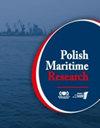Numerical Analysis of Resistance Characteristics of a Novel High-Speed Quadramaran
IF 2
3区 工程技术
Q2 ENGINEERING, MARINE
引用次数: 0
Abstract
Abstract This paper utilised computational fluid dynamics (CFD) technology to calculate the resistance of a novel high-speed quadramaran in calm water using the Navier‒Stokes (N‒S) equation, analysed the total resistance, frictional resistance, and residual resistance characteristics of this novel high-speed quadramaran at different length Froude numbers, and compared them with the results of a conventional high-speed catamaran with the same displacement. The results showed that the total resistance of the quadramaran had a significant hump at the Froude number of 0.6, due to the complexity of the wave interference among the four demihulls, and the hump value was about 1.6 times that of the catamaran. Above the hump speed, the total resistance of the quadramaran decreased with the increase of the Froude number, until reaching the Froude number of 1.06, when the curve became flat, and it showed a maximum resistance reduction of 40% at the Froude number of 1.66 compared with the catamaran, where the total resistance curve was steep. The frictional resistance of the quadramaran increased gradually with the growth of the Froude number, which was basically consistent with the change trend of the catamaran. The residual resistance of the quadramaran first rose and then reduced with the rising Froude number, the curve showed a large hump due to the adverse wave interference, and the hump value was about 1.7 times that of the catamaran. Above the Froude number of 1.06, as the wave interference changed from adverse to favourable, the quadramaran had lower residual resistance than the catamaran. The bow and stern demihulls of the quadramaran were also analysed for their resistance characteristics. The total resistance of the bow demihulls increased gradually with the increase of the Froude number, the curve had a small hump at the Froude number of 0.7, and above the hump speed, the curve was steep. The total resistance of the stern demihulls first increased and then decreased with the growth of the Froude number, the hump value at the Froude number of 0.85 was significant and was about 2 times that of the bow demihulls, and the curve became flat above the Froude number of 1.51.一种新型高速四驱车阻力特性的数值分析
摘要利用计算流体力学(CFD)技术,利用Navier-Stokes (N-S)方程计算了一种新型高速四体船在平静水中的阻力,分析了该新型高速四体船在不同长度弗劳德数下的总阻力、摩擦阻力和剩余阻力特性,并与相同排水量的常规高速双体船的结果进行了比较。结果表明,由于四个半船身之间波浪干涉的复杂性,四体船的总阻力在弗劳德数0.6处出现了显著的驼峰,驼峰值约为双体船的1.6倍。在驼峰航速以上,四体船的总阻力随弗劳德数的增加而减小,直到弗劳德数为1.06时,总阻力曲线趋于平缓,在弗劳德数为1.66时,与总阻力曲线较陡的双体船相比,阻力最大减小40%。随着弗劳德数的增加,四体船的摩擦阻力逐渐增大,这与双体船的变化趋势基本一致。随着弗劳德数的增加,四体船的剩余阻力呈先上升后降低的趋势,由于逆波的干扰,曲线呈现一个较大的驼峰,驼峰值约为双体船的1.7倍。在弗劳德数1.06以上,当波浪干涉由不利变为有利时,四体船的剩余阻力低于双体船。对四体船艏、艉半船身的阻力特性进行了分析。随着弗劳德数的增加,船首半壳总阻力逐渐增大,在弗劳德数为0.7时,曲线出现一个小的驼峰,在驼峰速度以上,曲线变得陡峭。随着弗劳德数的增加,尾半船身总阻力先增大后减小,在弗劳德数0.85处驼峰值显著,约为艏半船身的2倍,在弗劳德数1.51以上曲线趋于平缓。
本文章由计算机程序翻译,如有差异,请以英文原文为准。
求助全文
约1分钟内获得全文
求助全文
来源期刊

Polish Maritime Research
工程技术-工程:海洋
CiteScore
3.70
自引率
45.00%
发文量
20
审稿时长
>12 weeks
期刊介绍:
The scope of the journal covers selected issues related to all phases of product lifecycle and corresponding technologies for offshore floating and fixed structures and their components.
All researchers are invited to submit their original papers for peer review and publications related to methods of the design; production and manufacturing; maintenance and operational processes of such technical items as:
all types of vessels and their equipment,
fixed and floating offshore units and their components,
autonomous underwater vehicle (AUV) and remotely operated vehicle (ROV).
We welcome submissions from these fields in the following technical topics:
ship hydrodynamics: buoyancy and stability; ship resistance and propulsion, etc.,
structural integrity of ship and offshore unit structures: materials; welding; fatigue and fracture, etc.,
marine equipment: ship and offshore unit power plants: overboarding equipment; etc.
 求助内容:
求助内容: 应助结果提醒方式:
应助结果提醒方式:


